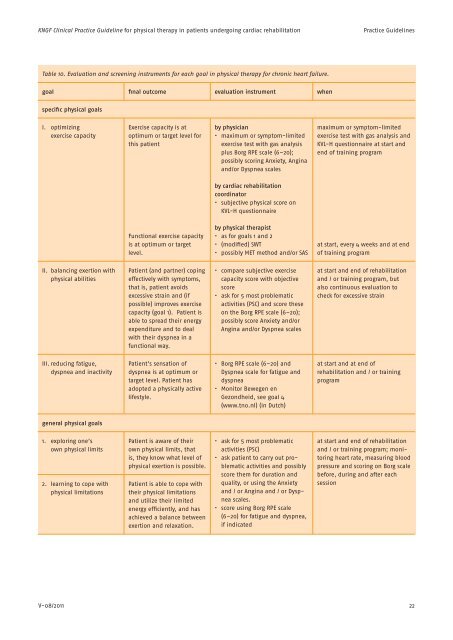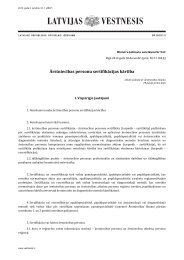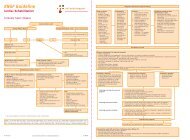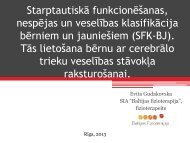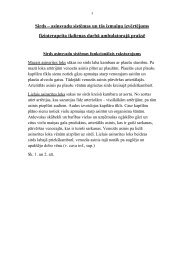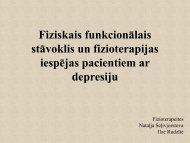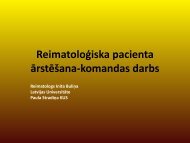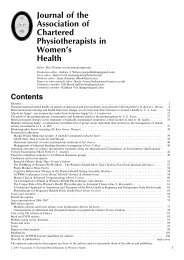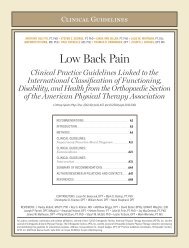KNGF Guideline Cardiac rehabilitation
KNGF Guideline Cardiac rehabilitation
KNGF Guideline Cardiac rehabilitation
You also want an ePaper? Increase the reach of your titles
YUMPU automatically turns print PDFs into web optimized ePapers that Google loves.
<strong>KNGF</strong> Clinical Practice <strong>Guideline</strong> for physical therapy in patients undergoing cardiac <strong>rehabilitation</strong><br />
Practice <strong>Guideline</strong>s<br />
Table 10. Evaluation and screening instruments for each goal in physical therapy for chronic heart failure.<br />
goal final outcome evaluation instrument when<br />
specific physical goals<br />
I. optimizing<br />
exercise capacity<br />
Exercise capacity is at<br />
optimum or target level for<br />
this patient<br />
by physician<br />
• maximum or symptom-limited<br />
exercise test with gas analysis<br />
plus Borg RPE scale (6–20);<br />
possibly scoring Anxiety, Angina<br />
and/or Dyspnea scales<br />
maximum or symptom-limited<br />
exercise test with gas analysis and<br />
KVL-H questionnaire at start and<br />
end of training program<br />
by cardiac <strong>rehabilitation</strong><br />
coordinator<br />
• subjective physical score on<br />
KVL-H questionnaire<br />
Functional exercise capacity<br />
is at optimum or target<br />
level.<br />
by physical therapist<br />
• as for goals 1 and 2<br />
• (modified) SWT<br />
• possibly MET method and/or SAS<br />
at start, every 4 weeks and at end<br />
of training program<br />
II. balancing exertion with<br />
physical abilities<br />
Patient (and partner) coping<br />
effectively with symptoms,<br />
that is, patient avoids<br />
excessive strain and (if<br />
possible) improves exercise<br />
capacity (goal 1). Patient is<br />
able to spread their energy<br />
expenditure and to deal<br />
with their dyspnea in a<br />
functional way.<br />
• compare subjective exercise<br />
capacity score with objective<br />
score<br />
• ask for 5 most problematic<br />
activities (PSC) and score these<br />
on the Borg RPE scale (6–20);<br />
possibly score Anxiety and/or<br />
Angina and/or Dyspnea scales<br />
at start and end of <strong>rehabilitation</strong><br />
and / or training program, but<br />
also continuous evaluation to<br />
check for excessive strain<br />
III. reducing fatigue,<br />
dyspnea and inactivity<br />
Patient’s sensation of<br />
dyspnea is at optimum or<br />
target level. Patient has<br />
adopted a physically active<br />
lifestyle.<br />
• Borg RPE scale (6–20) and<br />
Dyspnea scale for fatigue and<br />
dyspnea<br />
• Monitor Bewegen en<br />
Gezondheid, see goal 4<br />
(www.tno.nl) (in Dutch)<br />
at start and at end of<br />
<strong>rehabilitation</strong> and / or training<br />
program<br />
general physical goals<br />
1. exploring one’s<br />
own physical limits<br />
2. learning to cope with<br />
physical limitations<br />
Patient is aware of their<br />
own physical limits, that<br />
is, they know what level of<br />
physical exertion is possible.<br />
Patient is able to cope with<br />
their physical limitations<br />
and utilize their limited<br />
energy efficiently, and has<br />
achieved a balance between<br />
exertion and relaxation.<br />
• ask for 5 most problematic<br />
activities (PSC)<br />
• ask patient to carry out problematic<br />
activities and possibly<br />
score them for duration and<br />
quality, or using the Anxiety<br />
and / or Angina and / or Dyspnea<br />
scales.<br />
• score using Borg RPE scale<br />
(6–20) for fatigue and dyspnea,<br />
if indicated<br />
at start and end of <strong>rehabilitation</strong><br />
and / or training program; monitoring<br />
heart rate, measuring blood<br />
pressure and scoring on Borg scale<br />
before, during and after each<br />
session<br />
V-08/2011<br />
22


